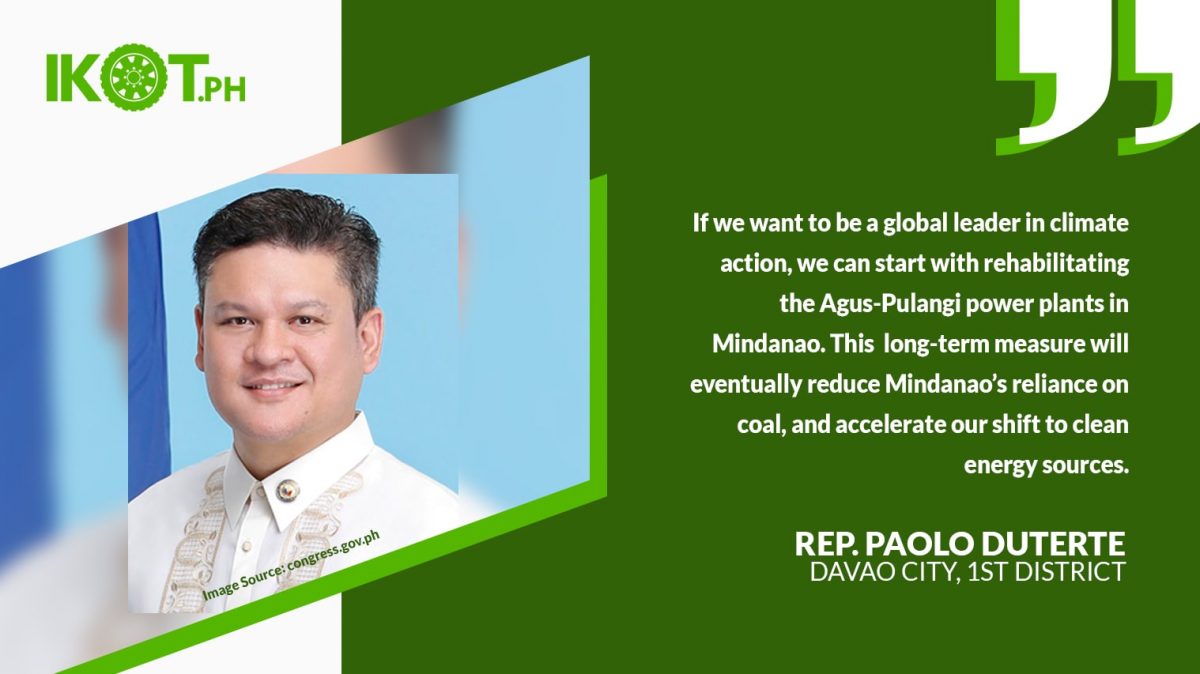Davao City 1st District Representative Paolo Duterte has called on the administration of President Ferdinand Marcos Jr. administration to prioritize the rehabilitation of the Agus-Pulangi hydropower complex if it wants the Philippines to be a “world leader” in climate action while ensuring a clean and reliable energy source in Mindanao.
Rehabilitating the decades-old facilities of the Agus-Pulangi power plants will jumpstart the country’s process of transitioning to low-emission energy sources and will contribute to its commitment to helping the world overturn the devastating effects of climate change, Duterte said.
Composed of seven hydropower plants, the Agus-Pulangi complex has an installed capacity of 1,001 megawatts, but only 600 to 700 MW is available because of the limitations of its old facilities.
“If we want to be a global leader in climate action, we can start with rehabilitating the Agus-Pulangi power plants in Mindanao. This long-term measure will eventually reduce Mindanao’s reliance on coal, and accelerate our shift to clean energy sources,” Duterte said.
Duterte issued his statement in response to Finance Secretary Benjamin Diokno’s recent pronouncement before a high-level Group of Twenty (G20) forum that the Marcos Jr. administration will continue to pursue a “whole-of-nation” approach to mitigating climate risks and is committed to being a world leader in the fight against the climate crisis.
According to Duterte, the Agus-Pulangi rehabilitation project will also help fulfill President Marcos Jr.’s goal of developing more renewable energy (RE) sources to meet the country’s power generation requirements.
Under the government’s National Renewable Energy Program (NREP) 2020-2040, the Department of Energy (DOE) is targeting to increase the share of RE sources in the power generation mix to at least 35 percent by 2030 and to more than 50 percent by 2040.
The Davao City lawmaker pointed out that prioritizing the rehabilitation of the Agus-Pulangi hydropower complex will also enable Mindanao to meet the ever-expanding energy requirements of its fast-growing economy.
“The infrastructure boom in Davao City and other parts of Mindanao has led to the emergence of many growth centers in the island. This means a corresponding increase in the energy we need to power our residential, commercial, and industrial developments,” Duterte said.
The administration of former President Rodrigo Duterte had planned the rehabilitation project of the plants in two stages.
“Thus, we expect the current administration to push through with the repair and rehabilitation of the Agus-Pulangi plants to ensure the reliability of the power supply in Mindanao now and in the years to come,” he added.
Duterte also expressed the hope that President Marcos Jr. will unveil his administration’s climate action agenda and long-term plans to reduce the country’s dependence on crude oil in his upcoming first State-of-the-Nation Address (SONA).
Last week, the Center for Ecology, Energy and Development (CEED), an organization advocating the use of RE sources, called on the Marcos Jr. administration to start the rehabilitation of the Agus-Pulangi hydropower complex in order to reduce Mindanao’s dependence on coal-fired power plants.
Composed of seven hydropower plants, the Agus-Pulangi complex has an installed capacity of 1,001 megawatts, but only 600 to 700 MW is available because of the limitations of its old facilities.
The administration of former President Rodrigo Duterte had planned the rehabilitation project of the plants in two stages. The first phase, involving the rehabilitation of four plants, is expected to generate 417 MW. The rest of the plants will comprise the second stage of the rehabilitation to generate an additional 512 MW. The project has been turned over to the Marcos Jr. administration.


